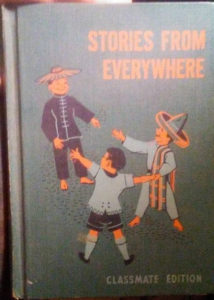Book Review: Stories from Everywhere by various authors
One of the joys of picking up random old books from Little Free Libraries, garage sales and discard bins is discovering rare volumes that have strayed far from their starting point. In this case, it’s a Developmental Reader from the California school system printed in 1954. A couple of pages are missing, so I don’t know what school it was used in, but some child must have loved it enough to bring home.
This book is meant for very young readers, introducing only a few new words per story. Each section is followed by some reading comprehension questions, most of which are pretty obvious, but some of which might need a teacher’s assistance.
The first section is “At the Zoo” which is primarily about zoo animals. In the first story, a little boy who has asked for a real elephant for his birthday is told that the new pachyderm at the zoo is “his.” It has to be held there, his mother explains, because there’s no room at home. Eventually Don must learn to share Butch with all the other children.
Next up is “Indians Then and Now” featuring what most of us now call Native Americans. It’s a very basic look at the cultures of Indians, but is refreshingly free of prejudicial language and emphasizes the variety of lifestyles in different regions of North America.
This is immediately followed by “Pioneer Days” about the movement of homesteaders west and their hardships. The best story here is little girl Sally figuring out how even she can contribute to the family’s meat supply. The chimney witch story is almost as good.
“If Animals Could Talk” is mostly realistic stories about wild animals living in nature, particularly beavers, but with the fictional ability to communicate with each other in words.
The book gets its name from the next section, “Lands Far Away,” with stories about children from Mexico, Bora Bora, China, Brittany and Switzerland. Most of these are reprints from Cricket, a long-running children’s literary magazine. These are nice stories mostly free from negative stereotypes.
“Did It Really Happen?” rounds out the volume with sillier animal tales, concluding with a cricket that learns to play the drum.
Overall, a nice collection of simple stories suitable for young readers even today. The one thing lacking that a modern reader would want is #ownvoices; it’s obvious from the author list that most of the writers are bog-standard white Americans.
Best of luck finding a copy in good condition!

